13 Herbal Teas to Prevent or Treat Menstrual Cramps
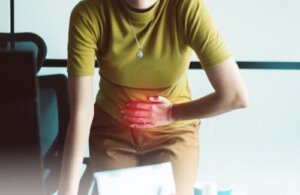

Reviewed and approved by the biologist Cesar Paul González
According to researchers, menstrual cramps are the leading cause of gynecological morbidity in women of reproductive age. The clinical name by which they are known is dysmenorrhea, and unfortunately it’s a very common problem. Fortunately, there are infusions to prevent or treat menstrual cramps that can be useful.
It is estimated that more than 50% of menstruating women suffer from this complication, and in some cases it can be very intense. There are two ways to treat the problem: with the help of pharmacological therapies and with home remedies. Today we focus on the latter, as we compile the best infusions to prevent or treat menstrual cramps.
What are menstrual cramps? What is dysmenorrhea?
Menstrual colic or dysmenorrhea occurs mainly in adolescents, usually one or two years after the first menstruation (menarche), when the ovulatory hormonal cycle is already established. It’s a pain in the belly area with variable intensity and duration.
It’s caused by the contraction of the muscles of the uterus before and during menstruation. These cramps usually disappear after the second or third day of the period.
They’re due to the fact that during menstruation a substance called prostaglandin is released, which causes contractions in the uterus. These contractions help the expulsion of desquamated uterine tissue.
However, some women suffer contractions so strongly that the blood vessels supplying the uterus are compressed, causing a temporary ischemia (angina of the uterus).

How are menstrual cramps classified?
Before talking about infusions to prevent or treat menstrual cramps, it’s necessary to classify them. There are two types of menstrual cramps: primary and secondary dysmenorrhea.
1. Primary dysmenorrhea
Primary dysmenorrhea is when menstrual cramps arise without any gynecological disease and occur from the first menstruation. It sometimes occurs due to hormonal changes or early menarche, and isn’t due to a specific physical condition.
2. Secondary dysmenorrhea
Secondary dysmenorrhea can be caused by gynecological diseases, such as endometriosis, fibroids, infections, or simpler issues such as stress or poor diet.
The pain appears after the first menstruation. It usually occurs in women after the age of 20 or 30.
What are the causes of menstrual cramps?
Among the factors that cause cramps during the menstrual period, we can differentiate between those of primary and secondary dysmenorrhea.
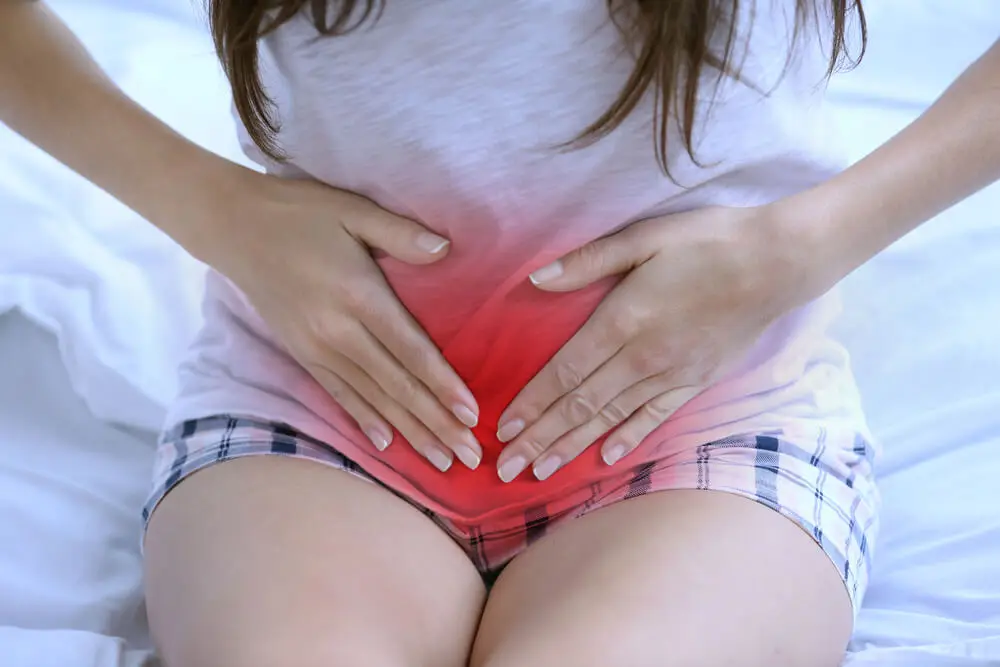
Causes or factors of primary dysmenorrhea
The main risk factor is age. In this sense, cramps are more common before the age of 20 and improve as women get older. Other risk factors include the following:
- Irregular menstrual cycles
- Family history of dysmenorrhea
- Never having had children
- Menarche (first menstruation) before the age of 12
- Heavy menstruation or menstruation lasting several days
Causes of or risk factors for secondary dysmenorrhea
As we have already pointed out, secondary dysmenorrhea is mainly due to an identifiable pathological condition. We highlight the following:
- IUD use
- Endometriosis
- Uterine fibroids
- Stenosis of the cervical canal (opening of the cervix so small that it prevents the outflow of menstrual flow)
- Some anatomical abnormalities, such as bicornuate uterus
- Pelvic inflammatory disease and other infectious diseases
- Ovarian cysts
Read more: The Natural Remedy of Ginger for Menstrual Cramps
Apart from pain in the stomach, what are the symptoms of menstrual cramps?
Menstrual cramps begin before menstruation, usually reducing progressively within 72 hours. Their intensity may vary during that time and the following symptoms may also occur intermittently:
- Dizziness
- Diarrhea
- Nausea
- Fatigue
- Headaches
- Leg cramps
- Back pain (which may extend to the lower back, kidneys or lower extremities).
Dysmenorrhea by itself doesn’t cause major health problems, although in some women the cramping is so intense that it affects their daily activities. Generally, dysmenorrhea improves as women get older, due to the progressive changes that the body undergoes.
Fortunately, there are many infusions that help treat menstrual cramps. These natural preparations not only help relieve pain, but also improve all other associated symptoms.
What’s the most recommended treatment?
The treatment of menstrual cramps consists of taking anti-inflammatory drugs. At the same time, good lifestyle habits should be practiced, such as maintaining good hydration and nutrition, regular physical exercise, and avoiding the consumption of substances that may promote discomfort, including alcohol.
13 infusions to prevent or treat menstrual cramps
Some home remedies prevent or treat menstrual cramps and the infusions that we’re going to discuss below also help to relieve the pain. In principle, they’re used to help ingest liquid and maintain good hydration. However, they won’t replace the pharmacological treatment prescribed by the specialist under any circumstances.
1. Chamomile, the best ally to prevent or treat menstrual cramps

Chamomile infusions are the most used to relieve menstrual cramps because it has multiple properties. It soothes, relaxes, reduces inflammation, and also helps to fall asleep at night, which makes it very beneficial.
The effects of this plant are scientifically based. Some studies highlight that chamomile is better than anti-inflammatory drugs for relieving menstrual pain in adolescents with primary dysmenorrhea.
Ingredients
- 2 teaspoons of dried chamomile leaves (10 grams)
- 1 cup of water (250 milliliters)
Preparation
- Add one cup of water to a pot and bring to a boil.
- Add the dried chamomile leaves and let them infuse for 10 minutes.
- Turn off the heat, strain and consume.
- You can sweeten it to taste, preferably with honey or whole cane sugar.
2. Ginger
Ginger root can relieve menstrual cramps because it has antispasmodic properties. That is, it helps muscle contractions to be reduced, and improves or regulates menstrual flow.
A review published in the journal Pain Medicine demonstrated the efficacy of ginger in the treatment of dysmenorrhea. The publication stated that consumption of between 750 and 2000 milligrams of powdered ginger during the first days of the menstrual cycle helps to reduce pain.
Ingredients
- 1 tablespoon of grated ginger (10 grams)
- 1 cinnamon stick
- Juice of ½ lemon
- 1 cup of water (250 milliliters)
Preparation
- Add the grated ginger and cinnamon to the water and bring to a boil.
- Let it infuse for 10 minutes over low heat.
- Turn off the heat and add the lemon juice to the hot water.
- Remove the grated ginger and cinnamon stick and serve in a cup.
- It’s advisable not to drink it too hot. You can consume up to 3 cups of this tea a day.
Read more here: The Properties and Uses of Ginger
3. Oregano infusion
According to popular wisdom, oregano infusion can relieve abdominal spasms and menstrual cramps, as well as the nausea that may occur during menstruation. If you prefer, you can combine oregano infusion with chamomile to enhance the calming effects.
Although there’s no scientific evidence to support the use of oregano infusion to relieve dysmenorrhea, the essential oil of the plant may be effective. A study of Journal of Obstetric and Gynaecology Research found that massages with lavender, oregano and sage essential oil reduce menstrual pain.
Ingredients
- 1 cup of water (250 milliliters)
- 1 teaspoon of oregano (5 grams)
- Honey or whole cane sugar (to taste)
Preparation
- Heat the water in a pot and, when it starts to boil, add the oregano and leave it on the heat for three minutes.
- Turn off the heat, cover the pot and let it stand for another 3 minutes.
- Strain and sweeten according to taste, or drink it plain.
4. Sage infusion
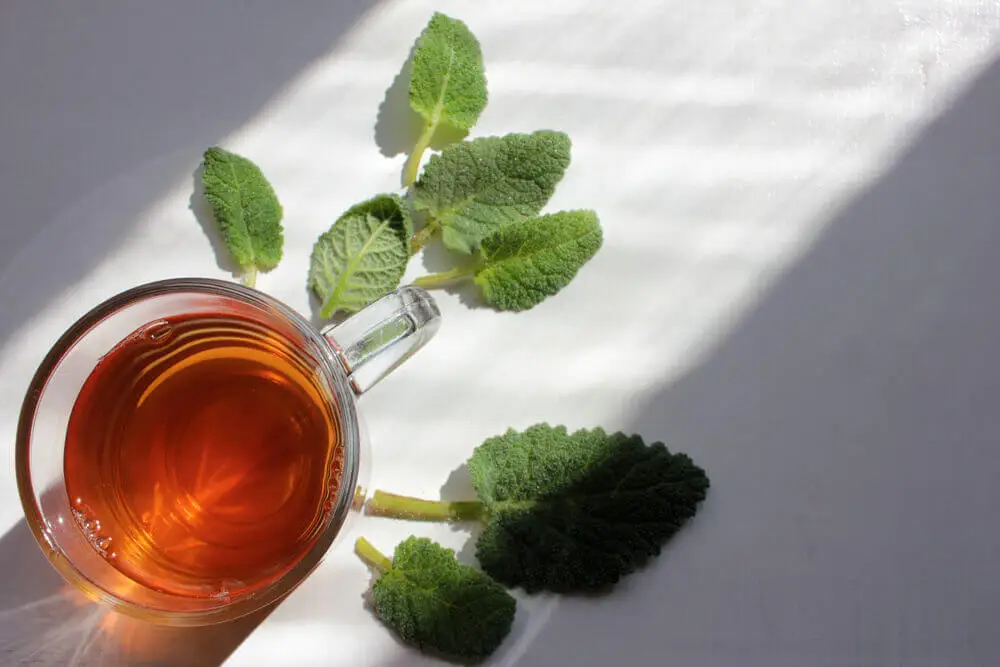
Because of its diuretic action, sage prevents fluid retention and the appearance of premenstrual syndrome symptoms, such as irritability and headaches. Because of this, it’s one of the best infusions to treat menstrual cramps. It’s recommended to take a cup of this infusion every day before menstruation.
The properties of sage allow it to provide quick relief. Although the infusion hasn’t yet been studied, the essential oil of Salvia sclarea L. can be used in aromatherapy against dysmenorrhea. Studies show that it inhibits the uterine concentration generated by oxytocin and it’s believed that the infusion has the same effect.
Ingredients
- 1 tablespoon of whole or crushed sage leaves (10 grams)
- 4 cups of water (1 liter)
Preparation
- Heat the water and, when it comes to a boil, add the leaves.
- Let it boil for 10 to 12 minutes.
- After the indicated time, remove it from the heat and let it stand.
- Strain and consume.
- You can add sweeteners such as honey if you feel the taste is too bitter.
5. Evening primrose infusion
Evening primrose can reduce the symptoms that appear with menopause. It’s also recommended for the relaxation of the uterus, but should be used sparingly manner to avoid adverse reactions.
Menstrual cramps can also appear as part of premenstrual syndrome. In this regard, evening primrose has been shown to be effective in reducing the symptoms of PMS according to several studies. However, more research is still needed.
Ingredients
- 4 cups of water (1 liter)
- 1 tablespoon of evening primrose leaves (10 grams)
- 1 teaspoon of honey (5 grams)
Preparation
- Heat the water with the evening primrose leaves.
- Cover and let stand for about 5 minutes.
- Strain, sweeten with a teaspoon of honey and consume.
6. Cinnamon
Cinnamon infusion provides very beneficial soothing effects to relieve menstrual cramps. It also works as an anticoagulant, preventing blood platelets from accumulating above normal levels, thus benefiting the flow of menstrual flow.
In addition, a study published in the Journal of International Medical Research showed that cinnamon is able to decrease the intensity of primary dysmenorrhea. In addition, the consumption of cinnamon infusions not only helps to alleviate menstrual cramps, but also helps to decrease the duration of the symptom.
Ingredients
- 2 cinnamon sticks
- 1 cup of water (250 milliliters)
Preparation
- Heat the water and, when it comes to a boil, add the two cinnamon sticks and boil for 2 minutes.
- Turn off the heat, cover, and let it stand for 5 minutes.
- Strain and consume.
7. Parsley
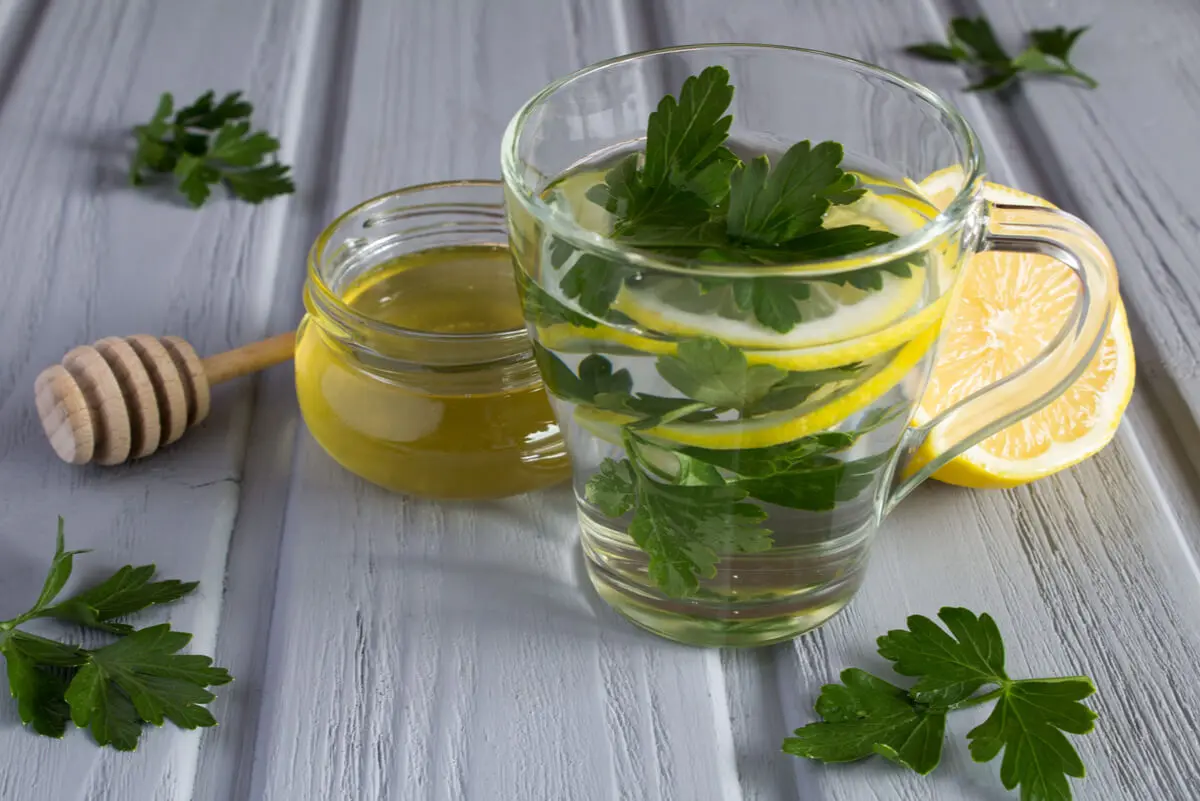
Although there’s no scientific evidence to confirm that parsley contains components with significant health benefits, it’s considered that infusions may be useful for treating menstrual cramps.
Ingredients
- 2 tablespoons of fresh parsley leaves (20 grams)
- 1 cup of water (250 milliliters)
- Optional: honey and lemon juice
Preparation
- Place fresh parsley in a cup and add boiling water.
- Let it steep for about five minutes.
- Strain, and it’s ready to drink.
- It’s very effective to take it three times a day during the first two days of your period.
8. Basil
Basil is a plant that has analgesic properties that could be useful when trying to relieve mild menstrual cramps. Moreover, as it has a delicious aroma, it comforts the person when they drink it.
Ingredients
- 1 tablespoon of basil leaves (10 grams)
- 1 cup of water (250 milliliters)
Preparation
- Boil the water with the basil leaves.
- Let it steep for about two minutes and consume.
- You can drink basil tea every two hours to try to relieve the cramps.
9. Fennel, another good ally against menstrual cramps
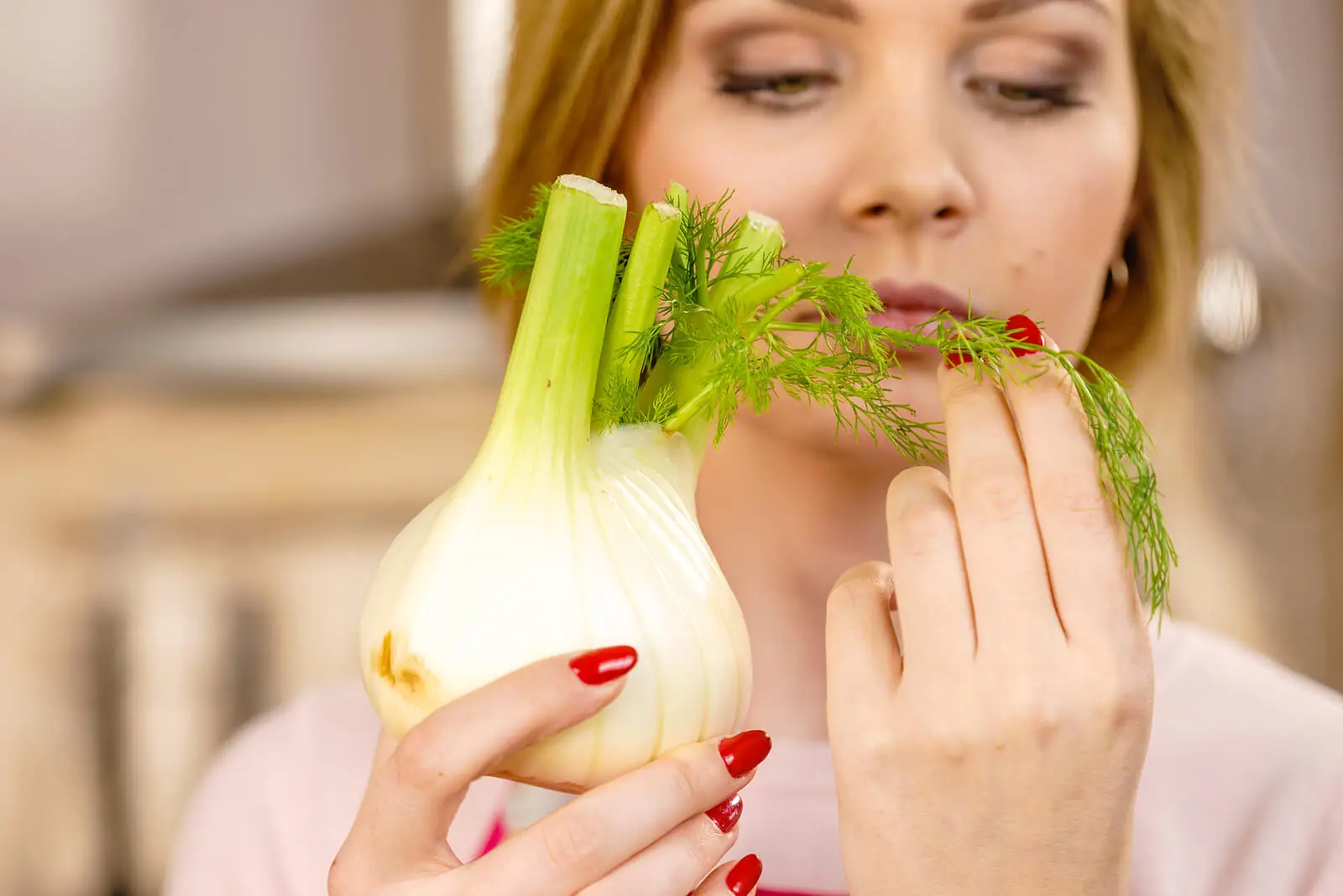
With fennel you can also prepare an infusion and relieve those annoying cramps thanks to its anti-inflammatory properties.
A bibliographic review published in the journal Nutrients showed that fennel has similar properties to drugs prescribed to treat pain. In this sense, its soothing effect for primary dysmenorrhea has adequate scientific support.
Ingredients
- 1 teaspoon of fennel seeds (5 grams)
- 1 cup of water (250 milliliters)
Preparation
- Add the fennel seeds to the water and boil the mixture for 5 minutes.
- Remove from heat, strain, and consume.
- The hotter you drink it, the better the results will be. If you drink it for three days before the arrival of your period, you won’t suffer from cramps.
10. Coriander seeds
Coriander seed has anti-inflammatory properties that help hydrate your body and generally relieve menstrual discomfort.
Ingredients
- 2 or 3 teaspoons of coriander seeds (10 or 15 grams)
- 2 cups of water (500 milliliters)
Preparation
- Boil the water together with the coriander seeds for 5 minutes.
- Let the infusion steep for 4 minutes and consume.
- You can drink 2 cups of tea a day.
11. Rosemary
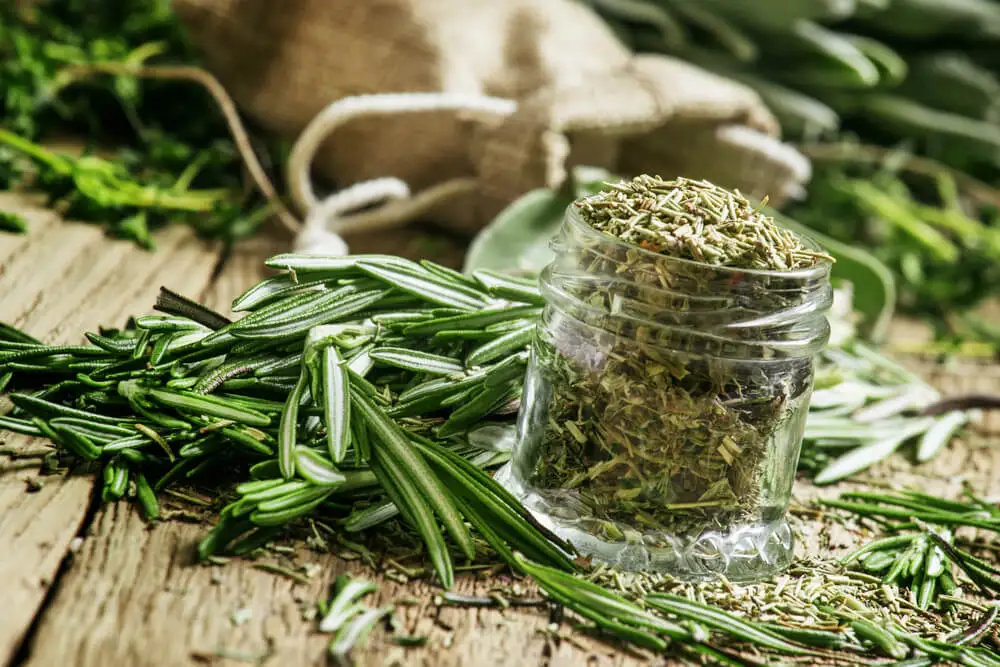
Because of its medicinal properties, rosemary is good for regulating menstrual periods. In fact, a recent study showed that rosemary capsules decrease menstrual bleeding and primary dysmenorrhea. However, the effect of the infusion hasn’t yet been thoroughly studied.
Ingredients
- 1 or 2 teaspoons of dried rosemary herb (5 or 10 grams)
- 1 cup of water (250 milliliters)
Preparation
- Heat the water and, when it begins to boil, add the rosemary.
- Let the infusion brew for 3 minutes.
- Then turn off the heat, cover the pot and let it stand for 8 minutes.
- Strain and sweeten to taste.
- You can drink two to three cups of rosemary infusion a day.
12. Valerian
Valerian is known for its analgesic and antispasmodic properties, making it one of the best infusions to treat menstrual cramps. In fact, a study by the Journal of Family Medicine and Primary Care showed that this plant is able to reduce menstrual bleeding and has analgesic effects in dysmenorrhea.
Ingredients
- 1 tablespoon of valerian root (10 grams)
- 1 cup of water (250 milliliters)
Preparation
- Put the water on the heat, and, before it boils, add the valerian root.
- Cover and let it stand for 5 minutes.
- Finally, strain and drink the tea.
- This infusion can be sweetened to taste, either with honey or sugar.
13. Star anise tea
Star anise is very useful to relieve belly pain during menstruation and relax the body. Anise infusions have analgesic and sedative properties that reduce abdominal discomfort, such as cramps. It’s recommended to be consumed 2 to 3 times a day during the period.
Ingredients
- 2 tablespoons of star anise
- 1 cup of water (250 milliliters)
Preparation
- Boil the water and add the star anise when it is boiling.
- Reduce the heat, and let it boil for 4 to 5 minutes over a low heat.
- Remove from the heat, cover and let it stand for 2 to 3 minutes.
- Strain the infusion and enjoy a pleasant tea.
- You can add other unscented medicinal herbs of your choice, such as chamomile.
What else should you keep in mind to relieve menstrual cramps?
As you can see, there are several options to stay well hydrated, and at the same time get relief in case of menstrual cramps. However, keep in mind that you shouldn’t use any of these infusions as the only way to treat menstrual cramps, especially if you continue to feel bad or get worse.
The best thing to do is to consult with your gynecologist about what measures you should take when you feel bad and follow their instructions.
All cited sources were thoroughly reviewed by our team to ensure their quality, reliability, currency, and validity. The bibliography of this article was considered reliable and of academic or scientific accuracy.
- Alimoradi, Z., Jafari, E., Abdi, F., & MGriffiths, M. D. (2023). Therapeutic applications of lemon balm (Melissa officinalis) for obstetrics and gynecological health issues: A systematic review. Journal of Herbal Medicine, 42, 100751. https://www.sciencedirect.com/science/article/abs/pii/S221080332300129X
- Antonescu Mintas, A. I., Miere Groza, F., Fritea, L., Ganea, M., Zdrinca, M., Dobjanschi, L., Antonescu, A., Vicas, S. I., Bodog, F., Sindhu, R. K., & Cavalu, S. (2021). Perspectives on the Combined Effects of Ocimum basilicum and Trifolium pratense Extracts in Terms of Phytochemical Profile and Pharmacological Effects. Plants, 10(7), 1390. https://www.ncbi.nlm.nih.gov/pmc/articles/PMC8309466/
- Aragón Muñiz, K. K., & Pulla Ortega, M. K. (2022). Estudio bibliográfico de la actividad antiespasmódica en origanum vulgare (orégano) y ruta graveolens (ruda) usado en mujeres durante la menstruación (tesis de grado, Universidad de Guayaquil). Repositorio Institucional UG. http://repositorio.ug.edu.ec/handle/redug/61383
- Bernardi, M., Lazzeri, L., Perelli, F., Reis, F. M., & Petraglia, F. (2017). Dysmenorrhea and related disorders. F1000Research, 6, 1645. https://www.ncbi.nlm.nih.gov/pmc/articles/PMC5585876/
- Crasta, S., Fernandes, P., & Paul, S. (2019). Ginger Tea on Dysmenorrhoea Among Nursing Students. Journal of Health and Allied Sciences, 9(2), 64-75. https://www.thieme-connect.com/products/ejournals/abstract/10.1055/s-0039-1700705
- Damayanti, A., Widiawati, I., & Nurchasanah, Y. (2022). The effect of peppermint tea on the severity of dysmenorrhea. Proceeding of The 4th International Conference on Interprofessional Health Collaboration and Community Empowerment, 3(2). https://conference.juriskes.com/index.php/IC/article/view/226
- Garjonyte, R., Budiene, J., Labanauskas, L., & Judzentiene, A. (2022). In Vitro Antioxidant and Prooxidant Activities of Red Raspberry (Rubus idaeus L.) Stem Extracts. Molecules, 27(13), 4073. https://www.ncbi.nlm.nih.gov/pmc/articles/PMC9268408/
- Gomathy, N., Dhanasekar, K. R., Trayambak, D., & Amirtha, R. (2019). Supportive therapy for dysmenorrhea: Time to look beyond mefenamic acid in primary care. Journal of Family Medicine and Primary Care, 8(11), 3487-3491. https://www.ncbi.nlm.nih.gov/pmc/articles/PMC6881953/
- Kalvandi, R., Alimohammadi, S., Pashmakian, Z., & Rajabi, M. (2014). The Effects of Medicinal Plants of Melissa officinalis and Salvia officinalis on Primary Dysmenorrhea. Avicenna Journal of Clinical Medicine, 21(2), 105-111. https://sjh.umsha.ac.ir/browse.php?a_id=89&sid=1&slc_lang=en
- Kural, M., Noor, N. N., Pandit, D., Joshi, T., & Patil, A. (2015). Menstrual characteristics and prevalence of dysmenorrhea in college going girls. Journal of Family Medicine and Primary Care, 4(3), 426–431. https://www.ncbi.nlm.nih.gov/pmc/articles/PMC4535108/
- Mahboubi, M., & Mahboubi, M. (2021). Pimpinella anisum and female disorders: A review. Phytomedicine Plus: International Journal of Phytotherapy and Phytopharmacology, 1(3), 100063. https://www.sciencedirect.com/science/article/pii/S2667031321000452
- Mohamed, A. S., Elkholey, G., Ramadan, S., El-Hakam, E. A. (2018). Comparison of Effectiveness of Fennel versus Vitamin (E) on Primary Dysmenorrhea among Benha University Nursing Students. Menoufia Nursing Journal, 3(1), 29-46. https://journals.ekb.eg/article_121861.html
- Nagy, H., & Khan, M. A. B. (12 de noviembre de 2023). Dysmenorrhea. StatPearls. https://www.ncbi.nlm.nih.gov/books/NBK560834/
- Niazi, A., & Moradi, M. (2021). The Effect of Chamomile on Pain and Menstrual Bleeding in Primary Dysmenorrhea: A Systematic Review. International Journal of Community Based Nursing and Midwifery, 9(3), 174–186. https://www.ncbi.nlm.nih.gov/pmc/articles/PMC8242407/
- Punoševac, M., Radović, J., Leković, A., & Kundaković-Vasović, T. (2021). A review of botanical characteristics, chemical composition, pharmacological activity and use of parsley. Archives of Pharmacy, 71(3). https://aseestant.ceon.rs/index.php/arhfarm/article/view/31544
- Swathi, S., Ranjini Murthy, P., Shravya, C. N., Vinaya Kumar, T., Prajwal, H. M., Balakrishna, R., Lakshmeesha, Nitesh, M. K., Vineetha, A. N., & Amshuman, R. Y. (2023). Efficacy of ginger tea and cinnamon tea on primary dysmenorrhea among young adults: A comparative study. Indian Journal of Integrative Medicine, 3(4), 107-112. https://mansapublishers.com/index.php/ijim/article/view/4362
- Tahoonian-Golkhatmy, F., Abedian, Z., Emami, S. A., & Esmaily, H. (2019). Comparison of Rosemary and Mefenamic Acid Capsules on Menstrual Bleeding and Primary Dysmenorrhea: A Clinical Trial. Iranian Journal of Nursing and Midwifery Research, 24(4), 301–305. https://pubmed.ncbi.nlm.nih.gov/31333746/
- Wal, P., Gupta, D., Wal, A., Pandey, S, S., & Krishnan, K. (2024). A Wholistic Approach to Non-Pharmacological Intervention for Primary Dysmenorrhea. Current Women’s Health Reviews, 20(1), 21-34. https://www.ingentaconnect.com/content/ben/cwhr/2024/00000020/00000001/art00005
- Xu, Y., Yang, Q., & Wang, X. (2020). Efficacy of herbal medicine (cinnamon/fennel/ginger) for primary dysmenorrhea: a systematic review and meta-analysis of randomized controlled trials. The Journal of International Medical Research, 48(6), 300060520936179. https://pubmed.ncbi.nlm.nih.gov/32603204/
This text is provided for informational purposes only and does not replace consultation with a professional. If in doubt, consult your specialist.








